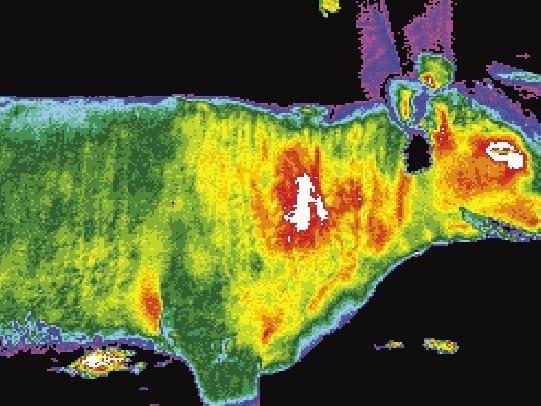Explore all the information on
Transition period in dairy cattle
Welcome to the page about Transition period in dairy cattle of Engormix; a source of knowledge on Transition period in dairy cattle.
Dr. Lance Baumgard, Professor at Iowa State University, speaks about a global problem: heat stress and its impact on economy, production and food security. He also mentions some dietary and management strategies to mitigate this problem and reduce the negative effects of heat stress which is becoming worse in the future due to climate change....
Comments : 0
Recommendations: 1
As technological advancements improve our ability to capture dairy performance data, our ability to manage and interpret that data becomes even more important. This is especially true when it comes to management of the transition cows. First and foremost, we need to observe and evaluate what the cows are telling us through their performance at both a group and individual level. We can do...
Comments : 0
Recommendations: 0
1. Introduction The major problems for the dairy practices in the tropical country are low milk yield and short lactation period of either pure exotic or crossbred dairy cattle. Many factors affect milk production in dairy cattle in tropical areas including high environmental temperature and humidity, lower genetic potential for milk production in indigenous cattle and inadequate supply of food during the dry and hot...
Comments : 2
Recommendations: 0
Dear colleagues, I have a dry cow pregnant for a second time which should give birth in about 30 days. It turns out that its appetite has reduced and it´s not eating the feed ration or the corn stover/silage as usual. Its physiological constants are normal. It is possible to feel "pasty" consistency to the rumen contents. Little ruminal movement. Faeces are few but mixed with a kind of grease, jelly-like but gelatinous content. Could...
Comments : 16
Recommendations: 0


Bioavailability of rumen-protected methionine: Mepron® contains the highest metabolizable methionine content among commercially available products
Suggested link
1. Introduction Crossbreed cows are kept for milk production by the peri urban dairy farmer and small scale rural farmer in Pakistan. These animals have emerged through genetic improvement of local non-discriptive cows leading to gradual improvement in milk yield. Resultantly they require improved feeding and management practices [1]. The improvement of ruminant milk quality has in many ways, been made possible by...
Comments : 2
Recommendations: 0
Research on Dairy Cows May Have Implications for Other Species
MANHATTAN, Kan. – Inflammation. The word typically has a negative connotation. Arthritis … infection … numerous maladies come to mind.
But a Kansas State...
Comments : 5
Recommendations: 0
Introduction The period from three weeks before to three weeks after parturition in dairy cows, also known as the transition period, is characterized by significant changes in hormonal profile, feed intake, nutrient requirements, metabolism, and energy balance. These changes are known to dramatically affect immune function. Consequently, cows are at greaterrisk of health disorders and mortality during early lactation. In the last week of...
Comments : 0
Recommendations: 0
Introduction
The multitude of disorders that dairy cows face during the transition to lactation is a perennial source of concern for dairy producers, nutritionists, and veterinarians. Total disease incidence in the several weeks after parturition accounts for a substantial proportion of all morbidity on many dairies, with particularly high rates of mastitis, metritis, milk fever, displaced abomasum, ketosis, and fatty liver, among...
Comments : 0
Recommendations: 0


Bioavailability of rumen-protected methionine: Mepron® contains the highest metabolizable methionine content among commercially available products
Suggested link
Coliforms and environmental streptococci were the most prevalent pathogens in clinical mastitis samples. The incidence of clinical mastitis in the first 100 days of lactation was significantly lower for the combination treatment than for the antibiotic treatment alone during both drought and rainy weather dry period. However, the reduction on incidence of clinical mastitis was significantly higher during rainy weather dry period (63.26%), compared with the drought weather dry...
Comments : 0
Recommendations: 0
The concept of setting goals and time constraints is not new in business management. But how does it apply to dairy farm management? In evaluating the production cycle of the dairy herd, a 100-day period of critical importance exists. The ‘100 day contract’ with the dairy cow begins 30 days before calving and runs through first breeding to 70 days postpartum. The terms of the contract include birth of a live calf with the cow remaining healthy during the transition period; high peak...
Comments : 4
Recommendations: 0
Healthy rumen microbe populations are important to dairy cows. Flourishing microbial populations can provide 50% to 80% of a dairy cow's daily protein requirement and up to 80% of its energy requirements. The remainder of the cow's nutrients comes from the level of recommended daily nutrients fed. In addition, research shows that well-managed herds with flourishing rumen microflora perform more consistently with smaller fluctuations in dry-matter intake, milk production and milk components....
Comments : 4
Recommendations: 0
Introduction Traditionally, management of cows during the dry period was minimal. Approximately 60 days before calving, milking would cease and cows were treated with long lasting antibiotic in an attempt to clear up any lingering subclinical mastitis and prevent new infections. Cows were typically removed from the milking herd, given reduced feed, and often exposed to pasture and allowed to "rest" prior to parturition. In the...
Comments : 2
Recommendations: 0
Transition cows diseases and Inflammation - Cause or Effect? Although strong links have been established between inflammatory markers and periparturient diseases, the interpretation of such associative data is difficult. It is possible that inflammation contributes to the etiology of some common early-lactation disorders, but it is also possible that undiagnosed subclinical conditions cause an increase in inflammatory mediators before disease diagnosis (Bradford et al., 2015)
What are your...
Comments : 0
Recommendations: 0
ABSTRACT This experiment was conducted to study the effect of supplemental chromium on performance and blood serum biochemistry of dairy cows. Thus twenty multiparous Holstein cows (parity 2 or 3) were equally divided into two groups. Group one, control, which received no chromium supplementation and group two, treatment group, received 5mg/day chromium methionine from week 5 prior to parturition until 12 weeks thereafter. Milk production and...
Comments : 5
Recommendations: 0


Bioavailability of rumen-protected methionine: Mepron® contains the highest metabolizable methionine content among commercially available products
Suggested link
Introduction The multitude of disorders that dairy cows face during the transition to lactation is a perennial source of concern for dairy producers, nutritionists, and veterinarians. Total disease incidence in the several weeks after parturition accounts for a substantial proportion of all morbidity on many dairies (Ingvartsen, 2006), with particularly high rates of mastitis, metritis, milk fever, displaced abomasum, ketosis, and...
Comments : 1
Recommendations: 0
What is the best feeding alternative for dry cows? What we can do in transition period to prevent acidosis, ketosis and fatty liver syndrome of milking cows in early lactation period? ...
Comments : 17
Recommendations: 0
Dry cow nutrition might not be the first thing on your mind given current challenges facing the dairy industry. However, proper dry cow nutrition is critically important to improve success in early lactation. Cows fed appropriately during the dry period transition more smoothly, have fewer health problems, and are more productive. It is important to develop a dry cow diet(s) based on a sound forage program. Most successful dry cow diets consist of approximately 70 to 80% forages;...
Comments : 1
Recommendations: 0
"If your cows are dry, they should be turned out and given water." I heard that statement as a joke many years ago when I was just a kid on the home dairy farm. No doubt, cows need water during their dry period. It's one of their basic requirements. It's part of what is needed to keep them comfortable. Dry cows need 20-30 gallons of water per day. The water needs to be fresh, clean and free of contaminants. But, keeping dry cows comfortable involves much more than making sure they...
Comments : 0
Recommendations: 0



.jpg&w=3840&q=75)















